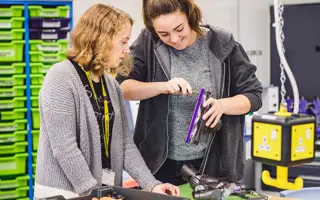News
A new approach to Design and Technology inspires more young engineers
The new approach encouraged a 37% increase in the number of students choosing to study the subject at GCSE when nationally the subject has seen a significant decline.

2020 GCSE results show a 23% drop in the number of students choosing to study Design and Technology1, a subject that is often a students’ first experience of engineering. Just half the number of pupils are taking the subject now compared to 2011, despite the new national curriculum demanding it to be taught in a more rigorous and challenging way, synonymous with real-life engineering.
James Dyson has been vocal about the crippling annual shortage of engineering graduates and technicians, which reached 59,000 in 2018.2 Engineering UK has found that while the engineering sector is growing and diversifying, this shift isn’t reflected in the education system.3
Today, the James Dyson Foundation reports on the results of a six year-long project which shows how the teaching of Design and Technology can be improved to make it more relevant to a career in engineering. The new approach encouraged a 37% increase in the number of students who chose to study the subject at GCSE, despite a national decline during this time, and as a result improved the perception of engineering careers amongst young people.
Sir James Dyson said, “As a society, we are failing to help young people by not connecting the science, design, technology and maths they learn in the classroom with the exciting and important engineering problems and solutions in the outside world. For our own part, we are doing what we can. Through the Dyson Institute of Engineering and Technology we are providing a degree education, developing cohorts of exceptionally bright young people into engineers who will be central to Dyson’s future. But to prime a pipeline of young people who want to study engineering, it is imperative that we inspire them about the potential of the career at the earliest possible stage. This starts with D&T in school.”
The approach
The James Dyson Foundation worked with five schools in Bath (UK) from 2012 to 2018. The aim was to transform the way the subject was taught, and develop a curriculum based on iterative design and problem-led learning – matching practices undertaken by Dyson engineers.
Funding was given to the schools to purchase new equipment so they could each create a state-of-the-art, industry standard laboratory space. Lessons were centred on real-world engineering challenges – such as coming up with design solutions to tackle an ageing population, renewable energy and road safety – and focused on developing practical skills relevant to engineering careers with increased student autonomy to encourage curiosity of thinking.
Improved perception and increased pursuit of engineering
As well as the increase in the number of students who chose to study the subject at GCSE, 156% more students said they would like to pursue a career in engineering. The project improved the relationship between gender and engineering. Over the course of the project the number of girls studying D&T in the schools increased from 16% to 38%. Notably, teachers also reported greater enjoyment teaching the subject, reporting it felt more accessible to all students. Dom Pridham, Curriculum Lead Design and Technology, Ralph Allen School said, “The work we’ve been doing with the James Dyson Foundation has made D&T more inspirational than it has ever been, with students solving real world problems and gaining life skills.”
Lydia Beaton, Global Head of the James Dyson Foundation said, “It is the hope of the James Dyson Foundation that this will encourage more students in the UK to study Design and Technology, so they can develop the vital technical skills and creative thinking needed to become the engineers of the future.”
What the James Dyson Foundation project has shown is that the UK education system should not resign itself to the idea of D&T’s demise. The Department for Education needs to recognise the urgent need to improve the provision of D&T. Design and Technology should be given a higher status in schools by making it into an English Baccalaureate subject, and funding and support should be provided to make it a more industry focused subject and better equip our future engineers. Read the full report
Sources
1 Engineering UK, ‘Engineering UK 2018: Synopsis and recommendations’, available at: www.engineeringuk.com/media/1576/7444_enguk18_synopsis_standalone_aw.pdf [accessed 02/05/18]
2 Dell Technologies, ‘Emerging technologies’ impact on society & work in 2030’, Institute for the Future, 2017, available at: www.delltechnologies.com/content/dam/delltechnologies/assetsperspectives/2030/pdf/SR1940 IFTFforDellTechnologies_Human-Machine_070517_readerhigh-res.pdf [accessed 18/10/18]
3 Engineering UK, ‘Engineering UK 2018: Synopsis and recommendations’, available at: www.engineeringuk.com/media/1576/7444_enguk18_synopsis_standalone_aw.pdf [accessed 02/05/18]
